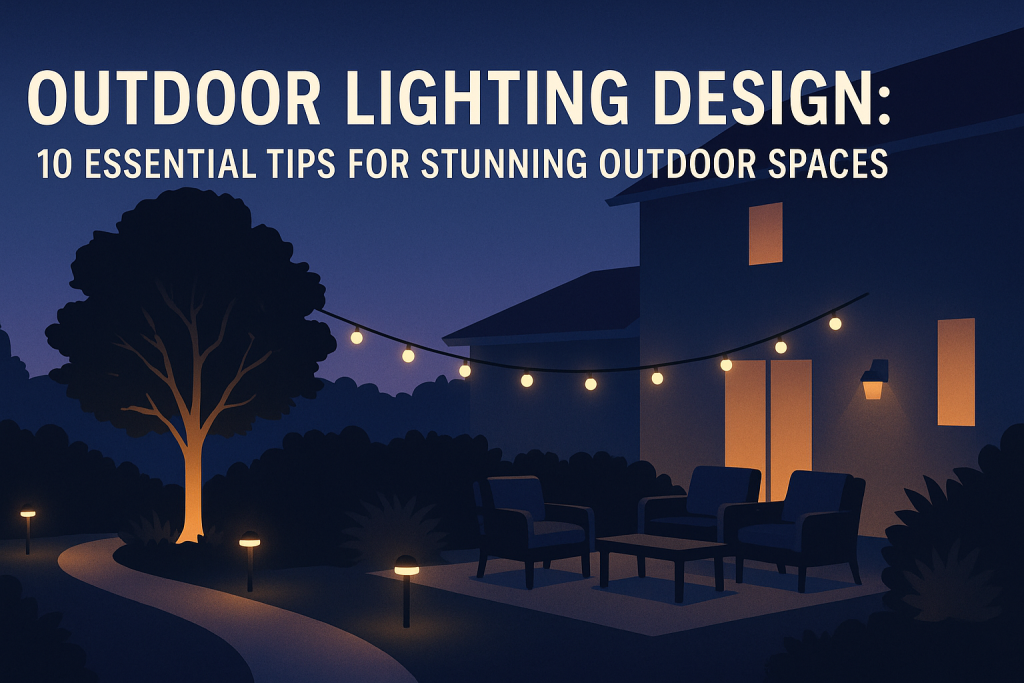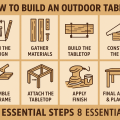Why Outdoor Lighting Design Matters
Creating an inviting and functional outdoor space goes far beyond landscaping and furniture placement. Outdoor lighting design is a critical element that enhances ambience, increases safety, extends usability, and highlights architectural and natural features. With strategic lighting, your yard can become a breathtaking retreat after sunset, offering both beauty and practicality.
Statistics show that well-designed outdoor lighting can increase property value by up to 20% and deter potential intruders by making your landscape less vulnerable. Investing in a thoughtful lighting plan transforms your outdoor area into a safe, enjoyable, and visually stunning environment.
1. Assess the Purpose of Your Outdoor Lighting
Define Key Areas and Functions
Before choosing fixtures or layouts, determine what you want your outdoor lighting to achieve. Is your goal to illuminate walkways for safety, create a cozy atmosphere for entertaining, or enhance curb appeal with dramatic highlights? Identifying your main objectives will guide every design decision.
Examples of Outdoor Lighting Goals
- Safety and Security: Illuminating steps, driveways, and entrances to prevent accidents and deter crime.
- Ambience: Creating a soft, inviting glow for relaxation or social gatherings.
- Aesthetics: Highlighting landscape features, architectural elements, or artwork.
2. Plan Your Lighting Layout Strategically
Map Out Your Outdoor Space
Sketch a simple map of your yard, patio, or garden, marking key features such as paths, trees, flower beds, and seating areas. Visualizing your space helps identify where lighting will have the most impact and prevents over- or under-lighting specific zones.

Consider Layered Lighting
Effective outdoor lighting design uses layers—ambient, task, and accent lighting—to create depth, functionality, and interest. Combining these layers ensures your yard looks stunning and meets all practical needs.
3. Choose the Right Types of Outdoor Lights
Popular Outdoor Lighting Fixtures
- Path Lights: Guide guests safely along walkways and driveways.
- Spotlights: Focus beams to highlight trees, sculptures, or architectural details.
- Floodlights: Broadly illuminate large areas for security and visibility.
- String Lights: Add a festive, whimsical touch to patios and pergolas.
- Step & Deck Lights: Enhance safety and visual appeal on stairs and decks.
- Wall Lights & Sconces: Provide functional and decorative illumination for entrances and walls.
Select Fixtures for Climate Resistance
Always choose fixtures rated for outdoor use, with appropriate weatherproofing for your local climate. Stainless steel, brass, and powder-coated aluminum offer excellent durability to withstand rain, snow, and sun exposure.

4. Highlight Key Landscape Elements
Feature Focal Points
Use accent lighting to draw attention to striking features such as mature trees, water features, or architectural columns. Uplighting, downlighting, and silhouetting techniques can create dramatic focal points and elevate your landscape’s visual appeal.
Balance Light and Shadow
Too much light can create glare and wash out features, while shadows add texture and intrigue. Aim for a harmonious balance by spacing lights thoughtfully and adjusting beam angles to avoid harsh spots.
5. Create Ambience with Layered Lighting
Combine Different Light Sources
Blending overhead string lights with low-voltage path lights and subtle spotlights creates an enchanting, layered look. Soft, warm white LED bulbs (around 2700K-3000K) are ideal for building a welcoming atmosphere without overpowering glare.

Dimmer Controls and Smart Lighting
Consider installing dimmers or smart controls to adjust brightness levels as needed. This flexibility allows you to set the perfect mood for quiet evenings or lively gatherings by the fire pit.
6. Prioritize Safety and Security
Illuminate Paths and Entryways
Accidents are more likely to occur in poorly lit areas. Use pathway lights, step lights, and wall-mounted fixtures to ensure safe navigation after dark. Statistically, well-lit exteriors can decrease the risk of falls by up to 50%.
Add Motion Sensors and TimersMotion sensor lights deter intruders and save energy by only activating when needed. Timers and dusk-to-dawn sensors automate lighting schedules, providing security even when you’re not home.

7. Use Energy-Efficient Lighting Solutions
LED Outdoor Lights
LED technology has revolutionized outdoor lighting by providing brilliant illumination with low energy consumption and long lifespans. LEDs use up to 80% less energy than traditional bulbs, helping you save on utility bills while reducing environmental impact.
Solar Power Options
Solar-powered lights are an eco-friendly alternative for areas with ample sunlight. They’re easy to install, require no wiring, and work well for accenting paths or garden beds. However, ensure they receive direct sunlight for optimal performance.
8. Prevent Light Pollution and Neighbor Disturbance
Shield and Direct Light
Use fixtures with shields or hoods to direct beams downward and prevent unwanted glare. This practice not only preserves night sky visibility but also respects neighbors’ privacy and reduces environmental light pollution.
Choose the Right Brightness
Overly bright lights can ruin ambience and cause discomfort. Select bulbs with appropriate lumens for their intended purpose, usually 100-200 lumens for pathways and 700-1300 lumens for security floodlights.
9. Installation Tips for Long-Lasting Results
Professional vs. DIY Installation
Many outdoor lighting systems can be installed as DIY projects, especially low-voltage and solar models. However, for extensive wiring or complex designs, hiring a professional electrician ensures safety, code compliance, and lasting performance.
Maintenance Best Practices
- Regularly clean lenses and fixtures to prevent dirt buildup.
- Check and replace bulbs as needed.
- Inspect wiring annually for signs of wear or damage.
10. Enhance Outdoor Lighting with Smart Technology
Smart Bulbs and Controls
Integrate your outdoor lighting with smart home systems to control lights remotely, automate schedules, and adjust color temperatures. Features like voice commands or smartphone apps add convenience and flexibility.
Integrating with Home Security
Connect outdoor lights to your home security system for real-time alerts and automated responses. For example, motion-activated lights can trigger cameras or alarms, further strengthening your property’s safety.
Conclusion: Transform Your Outdoors with Effective Lighting Design
Thoughtful outdoor lighting design is much more than just installing a few fixtures—it’s about creating a functional, beautiful, and secure extension of your living space. By following these 10 essential outdoor lighting tips, you can enhance curb appeal, boost safety, and craft unforgettable experiences in your garden, patio, or yard. Whether you’re a DIY enthusiast or working with a professional, investing in smart, purposeful lighting will pay off for years to come.
Frequently Asked Questions About Outdoor Lighting Design
How can I save energy with outdoor lighting?
Use LED fixtures, motion sensors, timers, and solar-powered lights to reduce energy consumption while maintaining adequate illumination.
What’s the best color temperature for outdoor lighting?
Warm white lights (2700K-3000K) are recommended for most outdoor spaces, as they create a cozy and inviting atmosphere without harsh glare.
Do I need a permit to install outdoor lighting?
Low-voltage and solar lighting usually do not require permits, but check local codes if you’re installing high-voltage systems or new electrical wiring.


